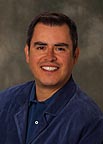October 01, 2007
Faculty member makes most of Boeing fellowship

Caption follows story
The associate professor in the Department of Technology at Southern Illinois University Carbondale recently got a spectacular insider's peek at how some of the world's largest, fastest and most-high tech machines are made, and in return gave his expert opinion to an icon of American industry.
Velasco spent two months during the summer as Welliver Faculty Fellow with The Boeing Co., the gigantic aerospace engineering and manufacturing company whose machines transport air travelers around the world and protect the United States and its allies. Velasco's record of teaching and research won him a spot on the prestigious panel — selected once a year by the company — which saw him travel throughout the country observing Boeing's various plants and processes.
As one of eight Welliver Fellows chosen nationally this year by the company, Velasco was the only industrial engineer in the group, which mostly consisted of aerospace and information systems engineers. As a result, the company tasked him alone with the "big picture" assignment of assessing its overall production systems and writing a report with recommendations for improving them using the principles of Six Sigma, a major quality control and improvement philosophy, and lean manufacturing, which seeks to reduce waste and improve speed.
"The idea was to give them my general observations, solutions, suggestions and ideas about how they do things, what they do well and what can be improved," Velasco said. "I was another set of eyes for them.
"It was a tremendous experience and I had a special opportunity because the other professors were assigned to projects and I was the only one traveling extensively," he said. "Boeing treated us like kings and the University has closer ties with the company as a result of our working together."
Velasco visited Boeing facilities in southern California, Everett, Renton and Seattle, Wash., St. Louis and elsewhere in his quest to size up the aerospace giant's systems. He visited the main assembly plants, climbing into aircraft as workers assembled them and conferring with engineers on the various processes. He visited the company's parts manufacturing factories and subcontractors. He visited plants where workers build subassemblies that eventually become part of the giant airliners and he studied the way the whole system functions from start to finish.
In the process, he was trusted with the company's proprietary secrets, which are closely guarded in the highly competitive field.
In Washington, Velasco witnessed production of a host of aircraft in the company's commercial aircraft division, including the 747, 767, 777 and 737. He also was on hand for the company's unveiling of the 787 Dreamliner, a revolutionary aircraft built mostly of lightweight composite materials instead of the traditional aluminum skin and members. The lighter weight coupled with more efficient engines promises to save air carriers millions of dollars in fuel costs, Velasco said, and the company already has sold about 700.
Elsewhere, he watched highly skilled technicians custom-build satellites and in St. Louis, he examined how some of the nation's frontline weapons systems and defense aircraft — the F-18, F-15 and C-17, for example — come together on the assembly floor. He also looked at the company's production of the wings and aft section of the new F-22 Raptor, which it does under a partnership with the aircraft's main contractor, Lockheed-Martin Aeronautics.
Velasco said it was a marvel to watch the mighty machines pieced together by skilled laborers and engineers. The company shared lots of information about its processes and asked for help in certain areas, he said.
"It's all about reduction in variation and quality control," he said. "I would spend my days in meetings with engineers and then on the floor watching them build the aircraft, looking at production and looking for problems that might be generalized at several facilities.
"They were very open with me," he said. "Some of the people I met at Boeing told me they had never seen the things I got to see." At the end of the fellowship, Velasco and others gave full reports to some of the company's top officers.
On the faculty at SIUC since 1993, Velasco said his work with the company will strengthen its relationship with the University. Company speakers will visit the University to give guest lectures and students will get to tour some of its facilities. Also, the Department of Technology will soon add another Boeing representative to its advisory board, he said.
